The 2022 CrossFit Open has arrived, and Whoop is one of the sponsors. Whoop makes a fitness tracking wearable and is one of many options. Fitbit, Garmin, Apple Watch, Samsung Watch, Oura, Whoop, Morpheus – all brands offer some tracking for certain health metrics. Things like resting heart rate, steps, HRV, recovery, sleep, etc. While the technology and what is measured has greatly evolved, there is a common measurement that all offer, that has not – your heart rate.
Tracking your heart rate, and heart rate based training, are nothing new. Orange Theory has commoditized this by having users earn “splat points” based on how high you can elevate your heart rate. At the other end of the spectrum, if you go into any old school fitness club and you’re bound to see a poster like the one below. And I’m sure everyone has heard that you can calculate your max heart rate by subtracting your age from 220. Is there any truth to any of this?

The reality is that heart rate based training, when used correctly, is a great way to ensure that you are training properly and regulating your training intensity. This ensures that you do not overtrain and burn yourself out. A couple times per month we perform Cardiac Output training, which is the proper term for steady state cardio. And we tell our members who wear trackables that HR should be 130-150 bpm during these workouts. If we wanted to be more specific, we would tell our members that during this training, we want to keep our HR to 60-70% of our max. The problem is most people don’t know their max heart rate.
We previously mentioned the 220 – (your age) formula. Unfortunately, this formula is completely arbitrary, and is based on almost nothing. In the 1970’s, a group of researchers looked at heart rate data for 35 people of various ages and came up with this equation as a VERY rough trend line. Subsequent research has shown that the number you calculate based on the formula is frequently off by 10-15 bpm.
So, if the equation is useless, how DO we measure max heart rate? Simple (but not easy). First, wear a heart rate monitor or tracker. Second, perform 3-4 max effort intervals, lasting 60-90 seconds, with 2-3 minutes of rest in between. You can do this on a bike, by running, or mixing modalities. We perform these short sprint intervals at Viking Athletics on a regular basis. However, your max HR will be position specific. So, you may end up with a higher max heart rate while running than while biking or rowing. If you’re really interested in heart rate training, it’s good to have both standing and seated numbers.
Once you have your max heart rates, try to calculate your heart rate zones. This should include the 50-60% range, 60-70%, 70-80%, 80-90%, and 90-100%. When it comes to workouts, we want to use the description of the workout and our heart rate data to make sure that we trained properly. Our HR should mostly serve as data – too much focus on it during a workout and you’ll lose focus on the workout. Now, here’s how we can use the zones.
| HR Zone | How It Feels | Movements | Sample |
|---|---|---|---|
| 50-60% | Conversational. Easily sustained for an hour. | Jogging, rowing, or biking, AKA cyclical movements. | 10 min row 10 min bike 10 min ski Easy pace |
| 60-70% | Slightly out of breath, but still conversational | Cyclical movements, step-ups, sit-ups, lightly weighted movements performed slowly | 4 Rounds for Completion: 100 Single Unders 20 Step-ups (20″ for all) 1000m Bike 20 Abmat Sit-ups 1000m Row Keep a conversational pace |
| 70-80% | Uncomfortable, but can be sustained for repeated bouts if there are built-in rest intervals. This type of pacing comes in to play during workouts longer than 7 minutes, like Open WOD 22.1. | Any movement can be used here. If athletes lack technical proficiency in a specific movement, they may drop out of this zone. | Every 4 Minutes for 4 Rounds: 20 Hang Power Cleans (75/55) 10 Thrusters (75/55) 10 Calorie Bike 10 Hollow Rocks Rest the remainder of each 4 min interval Or As Many Rounds as Possible in 15 Minutes: 19 Wallballs (20/14) 19 Calorie Row |
| 80-90% | Short, intense, and uncomfortable. Effort cannot be sustained without lengthy periods of rest. | Any movement can be used here. If athletes lack technical proficiency in a specific movement, they may drop out of this zone. | “Grace” For Time: 30 Clean and Jerks (135/95) |
| 90-100% | Max Effort. Cannot be duplicated without a full rest | Full body movements, or hard effort cyclical movements | 10 Rounds: 0:15 Calorie Assault Bike 90 seconds’ rest |
Of course, as with everything, effort matters here. In the high and low heart rate ranges, if you’re not appropriately pushing or backing off in accordance with the goal of the workout, you won’t achieve the intended stimulus of the workout. This is where having heart rate data can be especially useful – it allows you to know if you hit the target of the WOD, went too easy, or went too hard.
In addition to ensuring we complied with the goal of the workout, having our heart rate data can be useful as we progress with our fitness, particularly when it comes to pacing cyclical movements. For some athletes, running and sustaining a 12-minute mile pace keeps them in the 60-70% heart rate zone. More aerobically inclined athletes can knock that down to an 8–9-minute mile pace. We can track the same thing for rowing and biking, and this will help us use these movements to lower our heart rates during longer or more intense workouts. The more data you have, the better you can strategize.
Lastly, I want to cover a few more terms that come up when heart rate training is discussed:

Aerobic Threshold: This is the heart rate at which your blood lactate raises above resting levels. Your muscles can’t generate 100% of their energy aerobically, so they start generating some energy from your anaerobic systems as well. Your breathing will be slightly elevated here, but still conversational. It’s your 60-70% range! The exact threshold can be measured in a lab or estimated using 180-(your age). Add 5 bpm to this if you’ve been exercising regularly, subtract 5 bpm if you haven’t, and add an additional 5 bpm if you’re over the age of 55 or under the age of 25.
Anaerobic Threshold: Also known as your lactate threshold, this is when your muscles produce more lactate than your body can clear. And above this point, lactate production increases exponentially with effort. This is why rowing slightly faster may shave 10 seconds off your time, but leave you completely gassed, forcing you to rest before moving on to another exercise. Training above this threshold cannot be sustained for lengthy periods without rest.
VO2 Max: This is the maximum amount of oxygen an individual can use during exercise. It has a linear relationship to heart rate.
Karvonen equation: It’s an equation that uses your max heart rate AND resting heart rate to calculate your training zones. It still requires measuring your max heart rate, which requires a heart rate monitor, making it largely a waste provided you keep wearing your monitor.
Hopefully, that clears things up when it comes to heart rate training. At the end of the day, it’s another source of data that we can use to enhance our training. But remember to check AFTER the fact. Getting too caught up in the numbers on your phone can interfere with your training, and lead to paralysis by analysis. See you in the gym.
